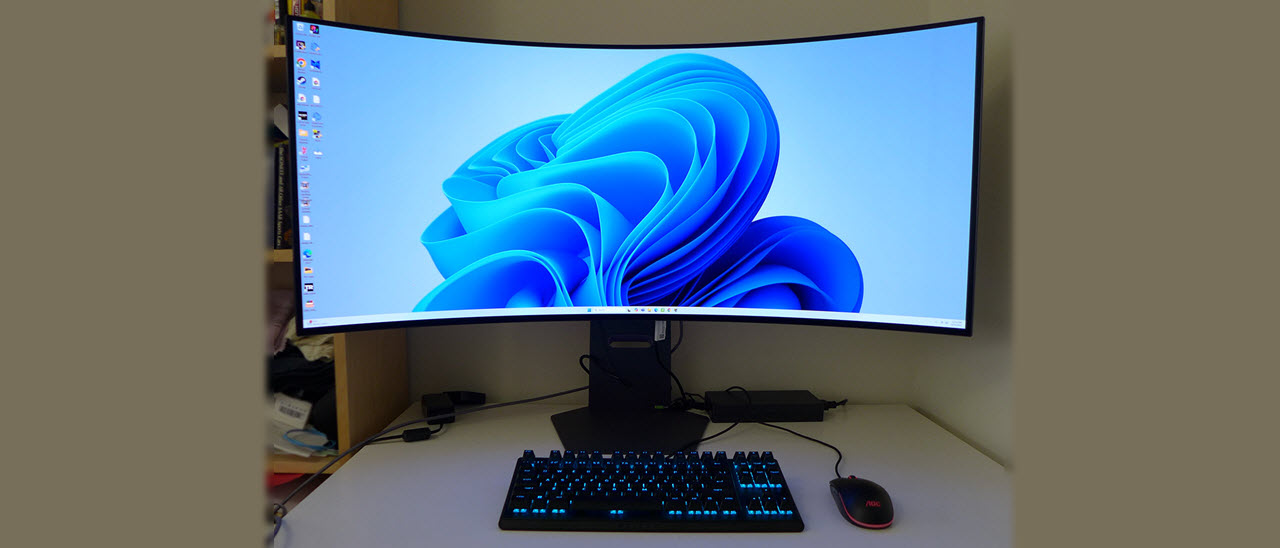Tom's Hardware Verdict
I noted a few gamma issues during calibration but aside from that, the LG Ultra Gear 45GX950A is a superb OLED gaming monitor for flying and racing simulation. The picture is stunning and the motion is smooth. With its extreme curve, you’ll be completely drawn into the gaming environment.
Pros
- +
Bright, sharp and colorful image with high pixel density
- +
Accurate without need for calibration
- +
Excellent video processing
- +
Flexible refresh rate modes
- +
Excellent sound with DTS Headphone:X support
- +
Premium build quality
Cons
- -
Gamma errors introduced by calibration
Why you can trust Tom's Hardware
Gaming can be a pleasure on many kinds of computer monitors, but when you have one perfectly suited to what you’re playing, the experience jumps to another level. The feeling of immersion is especially important in racing or flying simulations. The sense of being in the car, plane, or spaceship heightens when you can wrap the screen around your viewpoint.
Simulators are dominated by the best gaming monitors with ultra-wide and mega-wide screens in either 21:9 or 32:9 aspect ratios. The mantra is, “the wider the better,” but height is essential too. Enter the 45-inch 21:9 category, where you get tremendous screen area and, if the curve is extreme enough, the true feeling of being in a cockpit.
LG’s Ultra Gear 45GX950A is ideally suited for driving and flying sims. It delivers a high pixel density of 125ppi with a 5120x2160 (5K2K) array on an OLED panel with an 800R curve. It also sports a 165 Hz refresh rate with a dual-mode switch to 330 Hz at 2560x1080, plus Adaptive-Sync, DisplayHDR 400, and wide-gamut color. Let’s take a look.
LG Ultra Gear 45GX950A Specs
Panel Type / Backlight | Organic Light Emitting Diode (OLED) |
Screen Size / Aspect Ratio | 45 inches / 21:9 |
| Row 2 - Cell 0 | Curve radius: 800mm |
Max Resolution and Refresh Rate | 5120x2160 @ 165 Hz |
| Row 4 - Cell 0 | 2560x1080 @ 330 Hz |
| Row 5 - Cell 0 | FreeSync and G-Sync Compatible |
Native Color Depth and Gamut | 10-bit / DCI-P3 |
| Row 7 - Cell 0 | DisplayHDR 400, HDR10 |
Response Time (GTG) | 0.03ms |
Brightness (mfr) | 275 nits SDR |
| Row 10 - Cell 0 | 1,300 nits HDR (1.5% window) |
Contrast | Unmeasurable |
Speakers | 2x 10w |
Video Inputs | 1x DisplayPort 2.1 |
| Row 14 - Cell 0 | 2x HDMI 2.1, 1x USB-C |
Audio | 3.5mm headphone output |
| Row 16 - Cell 0 | DTS:Headphone X |
USB 3.2 | 2x down |
Power Consumption | 85.3w, brightness @ 200 nits |
Panel Dimensions WxHxD w/base | 39 x 21.5-26.2 x 13.5 inches (991 x 546-665 x 343mm) |
Panel Thickness | 8.9 inches (226mm) |
Bezel Width | Top: 0.28 inch (7mm) |
| Row 22 - Cell 0 | Sides: 0.35 inch (9mm) |
| Row 23 - Cell 0 | Bottom: 0.47 inch (12mm) |
Weight | 30.9 pounds (14kg) |
Warranty | 2 years |
If you’re building a driving or flying simulator, a monitor like the 45GX950A is a natural choice. You could expand your view with multiple screens, but then there are those annoying dividing lines that you can’t unsee. A 32:9 screen brings the width, but current 49-inch models aren’t very tall. They impart a view that’s like looking out of a racing helmet, which is fine for driving but not so much for flying.
45 inches at 21:9 means 18 inches vertical, more than a 32-inch 16:9 monitor. To bring the sides into the user’s peripheral vision, the 45GX950A has a very tight 800R curve radius. That means a circle of them would only be 1.6 meters across. It’s so tight that you can hear your voice bounce off the sides of the screen — it’s a unique experience.
Onto the important stuff: The 45GX950A is a very high-resolution panel with a resolution of 5120x2160 pixels. That equates to 125 pixels per inch, denser than a 27-inch QHD monitor but not quite as dense as a 32-inch Ultra HD screen. It’s more total pixels — over 11 million — so fast frame rates will require a stout video card.
However, you won’t need to worry about motion blur, thanks to the 45GX950A’s OLED panel. It doesn’t have a Quantum Dot layer, but the color gamut covers almost 98% of DCI-P3, so the vivid saturation is there. You also get high brightness with 1,300 claimed nits in HDR mode for a 1.5% window. I measured 673 nits from a 25% window so that tracks. There are two levels of variable brightness as well, so SDR peaks can top 450 nits.
Get Tom's Hardware's best news and in-depth reviews, straight to your inbox.
The native refresh rate is 165 Hz, and you get a 330 Hz mode at 2560x1920 resolution. It’s easily accessed with a switch in the OSD. The 45GX950A is certified G-Sync Compatible and for FreeSync Premium Pro as well. There’s plenty of bandwidth available through the DisplayPort 2.1 input, and you get two HDMI 2.1 ports, along with a USB-C port that supports DisplayPort and delivers 90 watts of power. Two USB downstream ports handle peripherals, and you get a nice pair of internal speakers. The headphone jack is a four-pole design that supports surround sound and DTS Headphone:X.
There is little that the 45GX950A doesn’t have, and all that goodness will cost you $1,600 at this writing. For that sum, you’re getting something relatively unique that brings a new level of immersion and realism to your favorite flying and driving simulators.
Assembly and Accessories
The 45GX950A arrives in a huge box with plenty of crumbly foam inside. It’s needed to support that extremely curved panel, and my sample showed up unscathed. The stand and base are substantial and assemble without tools. Cables include DisplayPort, HDMI, and USB-C. You also get an enormous external power brick that thankfully has a cord long enough that you can put it on the floor.
Product 360

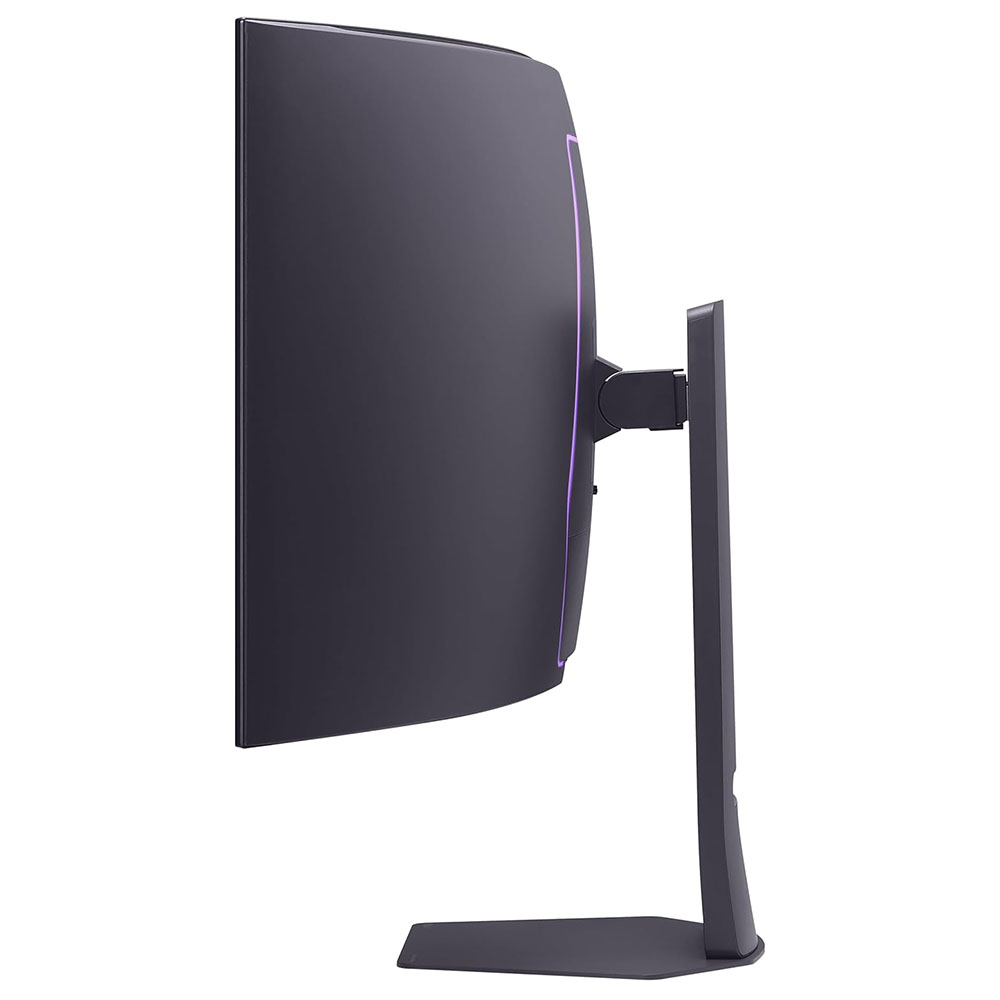


The 45GX950A is impressive from any angle, not only in size but in shape. An 800R curve is tighter than anything you’ve seen before, unless you read my review of the AOC AG456UCZD, which is the same size but has lower resolution. When you sit two or three feet from the screen’s center, the sides aren’t that far from your ears. It’s about as immersive as you can get short of VR goggles.
The stand has a relatively small footprint thanks to its heavy cast metal base. The upright is wide and features a 4.7-inch height range, plus 10/15 degrees tilt and 10 degrees swivel. I appreciated that it set the screen high enough to keep it perfectly vertical with my eyepoint centered. This is especially important for a monitor as curved as the 45GX950A. Any tilt ruins the immersive effect. The height adjustment is firm, nicely dampened, and wobble-free.
The back is perfectly smooth and features a ring of LEDs controllable from the OSD and an LG logo. The cable hole in the upright is trimmed in purple. Underneath the center is a single joystick that controls all monitor functions. The headphone jack is also under the front edge, making it easy to access. The remaining ports are up and under and include two HDMI 2.1 ports, a DisplayPort 2.1 port, and a USB-C port with DisplayPort function and 90 watts of power. You also get two USB downstream ports. A snap-on cover helps to hide the cabling.
OSD Features
The 45GX950A’s OSD appears when you press the joystick. It’s game-focused with a slick look that includes color and fade effects, with important info always displayed at the top.
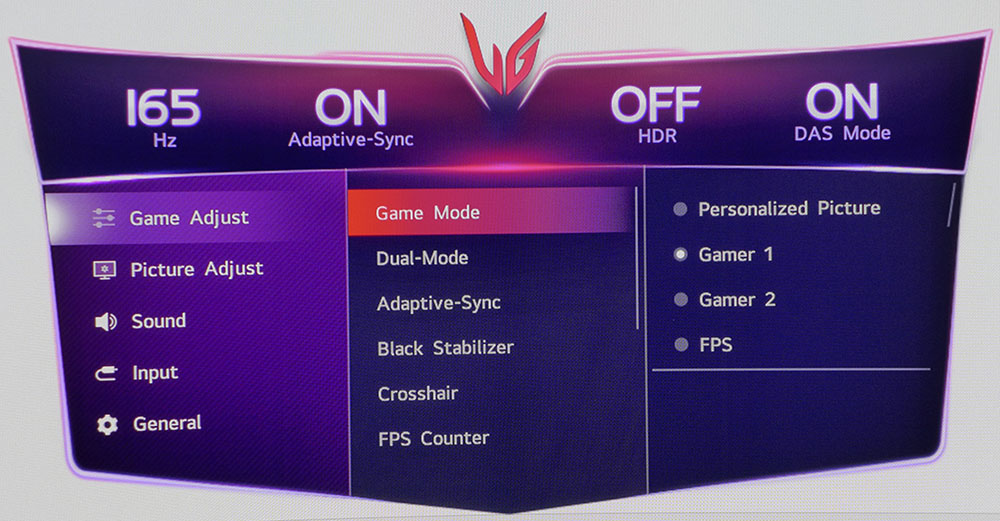

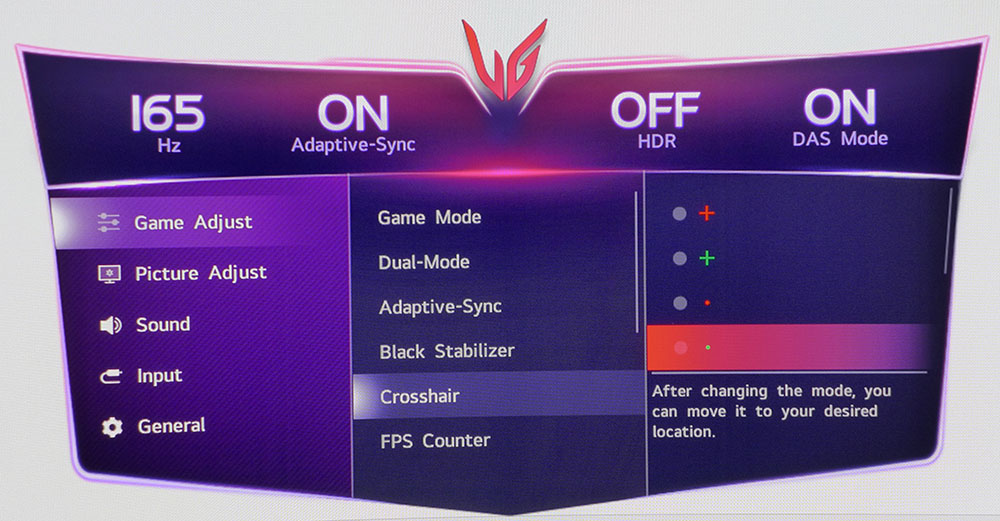

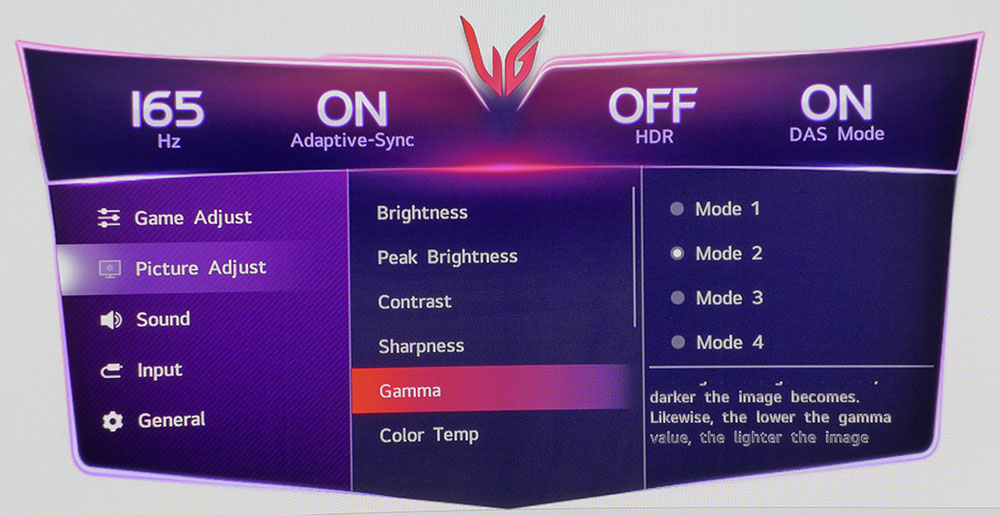


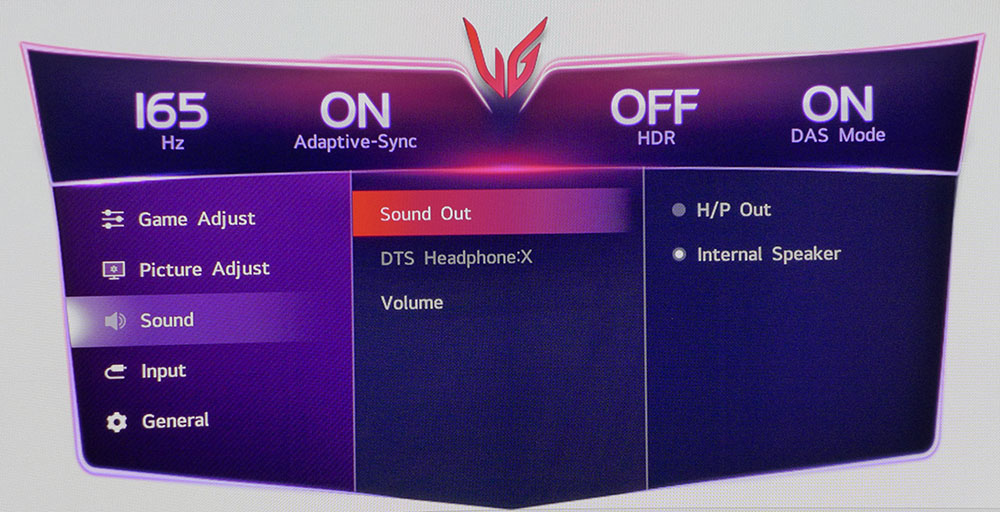
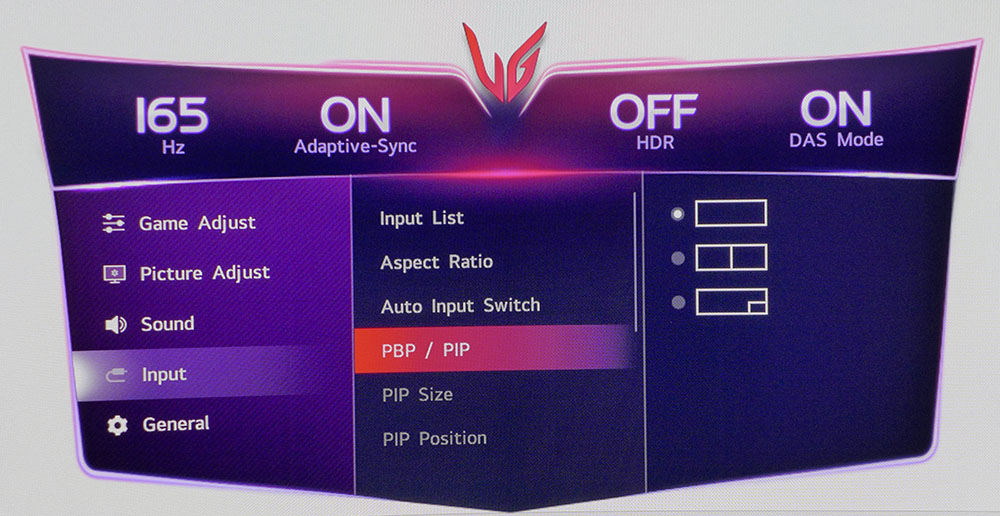
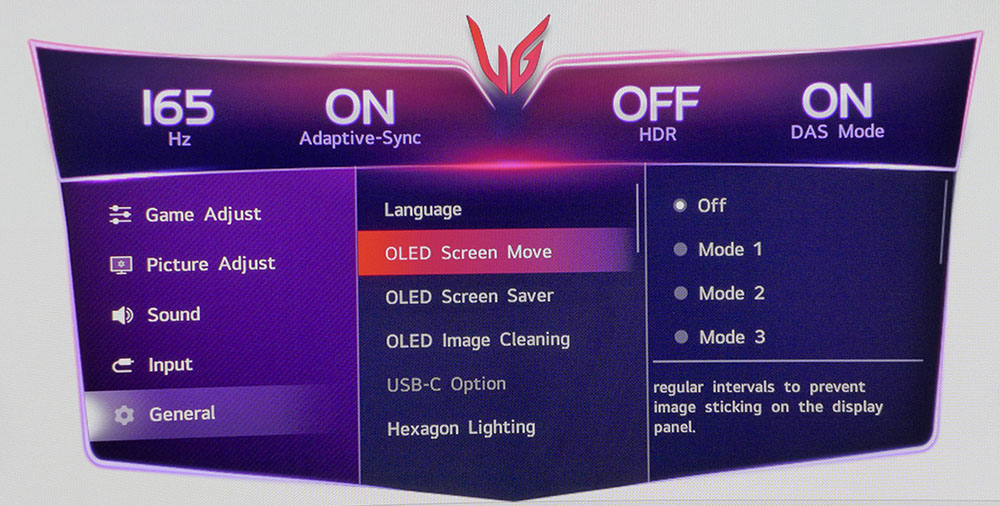
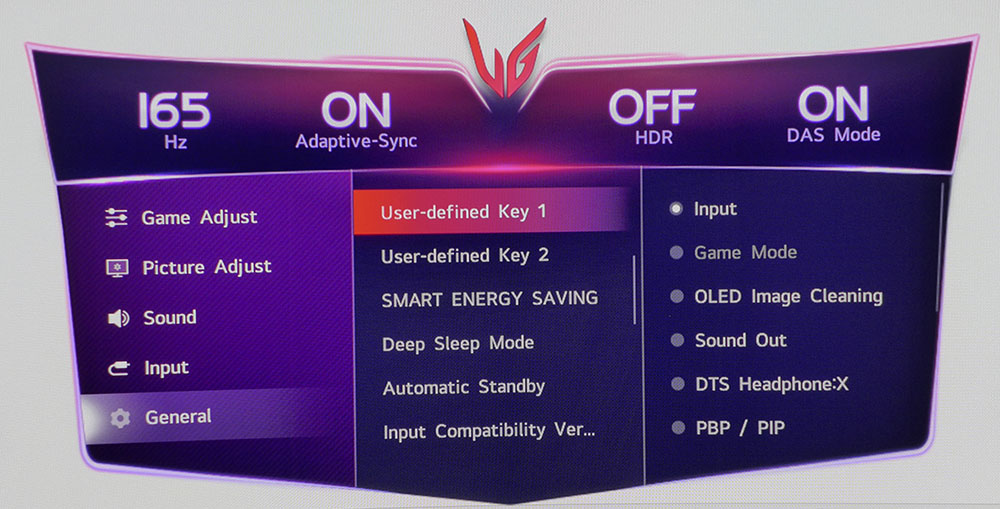
Game Adjust is the first menu up, and it starts with the 45GX950A’s picture modes. There are 13 in total, including sRGB, HDR emulation, and two calibration memories that work with LG’s Calibration Studio app. Personalized Picture is another memory that connects with the LG Switch app.
Dual-Mode is the refresh rate/resolution toggle, offering 5120x2160 at 165 Hz and 2560x1080 at 330 Hz. You can also change the aspect to 16:9 or 21:9/39” to accommodate games that distort the image at full-screen settings. The switch was seamless every time; I didn’t need to set it up in the Nvidia Control Panel beforehand. LG and I recommend that you make the switch before starting up a game. Additional gaming aids include aiming points and a frame rate counter.
In the Picture Adjust menu, you’ll find the Peak Brightness setting, which is LG’s term for variable brightness. It has two levels, both of which render the image without clipping. On High, you’ll get 457 nits for SDR and 673 nits for HDR from a 25% window pattern. That’s very bright indeed. This menu also has four gamma presets and five color temps. Manual changes the temp by Kelvin value, and Custom uses the RGB sliders to help tweak grayscale tracking. You also get hue and saturation sliders for all six colors. If you get lost during calibration, you can reset just this menu.
Sound comes from two internal speakers that play with 10 watts of power. Or you can use the headphone output, which supports DTS Headphone:X. This requires compatible headphones with a four-pole connector, but once plugged in, the surround-sound experience is incredible. If you typically play with headphones, I recommend going for DTS Headphone:X models. It takes audio to another level.
The 45GX950A supports PIP and PBP, so you can view two video signals at once. The side-by-side view is especially useful if you have a PC and console hooked up. In the General menu are OLED care options that include pixel orbiting, a screen saver and image cleaning, which runs automatically at regular intervals. And the two of the joystick directions are programmable for different quick access functions.
LG Ultra Gear 45GX950A Calibration Settings
The 45GX950A can be enjoyed without calibration in its default Gamer 1 mode. When I tweaked the RGB sliders, I was able to improve grayscale tracking slightly, but gamma was negatively affected. I wound up leaving the settings at their defaults for the best picture. Color is spot-on in either case. I noted that the sRGB mode allowed calibration, which is something I rarely see. I’ve provided my brightness settings below. They are valid when Peak Brightness is turned off. If you use the high or low setting, you might need to lower them a tad to compensate.
In HDR mode, you get six of the 13 picture modes, Gamer 1 is still the best. You can also adjust brightness, and the Peak Brightness setting is available too, which is a nice touch. Most monitors have no brightness options in HDR mode.
Picture Mode | Gamer 1 |
Brightness 200 nits | 88 |
Brightness 120 nits | 66 |
Brightness 100 nits | 60 |
Brightness 80 nits | 53 |
Brightness 50 nits | 39 (min. 13 nits) |
Gaming and Hands-on
I rarely have a new gameplay experience, given the over 450 monitors I’ve reviewed in the past 10 years. But the 45GX950A provided just that. You’ve undoubtedly heard the cliché, “it brings the action closer.” Well, it does, truly. I had to readjust my perceptions when playing familiar maps in Doom Eternal and Call of Duty WWII. Getting close to enemies makes them uncomfortably close until you adapt.
Movement and control are blindingly quick. I had no trouble with lag or hesitation of any kind. 165 Hz means there’s a tiny bit of motion blur, but it never distracted during gameplay. I played for a bit at 330 Hz and found it was smoother, but the loss of resolution was significant. While I gained clarity by removing all traces of blur, it was lost in the lowered pixel density. I noted that it was no problem to maintain 165 fps using a GeForce RTX 4090. This same setup typically runs around 220 fps with the best 4K gaming monitors.
The HDR image was simply stunning. The 45GX950A is a bit brighter than other ultra-wide OLED monitors I’ve reviewed. That made up for its lack of Quantum Dot color. It was rich and vibrant with highlights that popped and deep shadow detail. It also had a textural quality that made me want to reach out and touch objects on the screen.
For daily use, the extreme curve took some getting used to. The 45GX950A is different from anything else except the AOC AG456UCZD which I reviewed last year. And the LG has a higher resolution than that screen, making it well-suited for graphics and photo work. There is some image distortion from the extreme curve, but it should be easy for users to adjust. It’s important to keep the screen vertical so your eyepoint is equal to all parts of the screen. The 45GX950A’s stand is high enough for this purpose.
My physical interactions with the 45GX950A were all positive. The menu is well laid out and easy to navigate using the joystick. I didn’t have to calibrate, so there’s little to no setup involved. The only choice to make is whether to use Peak Brightness or not. This is LG’s version of variable brightness, and it has low and high settings. I left it off for work tasks, set it on low for video, and high for HDR content. That extra flexibility was a nice touch that not all HDR monitors have.
Takeaway: Despite its extreme shape and size, the 45GX950A is a superb gaming monitor in all respects. It might be a little too in-your-face for shooters, but I can’t imagine a better screen for racing or flying sims. The dual refresh feature isn’t terribly useful because it lowers pixel density too much. But it was more than smooth and responsive enough at 165 Hz to be addictive. This is truly a monitor to crave. It takes gaming to a new level of immersion and realism.
MORE: Best Gaming Monitors
MORE: How We Test PC Monitors
MORE: How to Buy a PC Monitor
Current page: Features and Specifications
Next Page Response, Input Lag, Viewing Angles and Uniformity
Christian Eberle is a Contributing Editor for Tom's Hardware US. He's a veteran reviewer of A/V equipment, specializing in monitors. Christian began his obsession with tech when he built his first PC in 1991, a 286 running DOS 3.0 at a blazing 12MHz. In 2006, he undertook training from the Imaging Science Foundation in video calibration and testing and thus started a passion for precise imaging that persists to this day. He is also a professional musician with a degree from the New England Conservatory as a classical bassoonist which he used to good effect as a performer with the West Point Army Band from 1987 to 2013. He enjoys watching movies and listening to high-end audio in his custom-built home theater and can be seen riding trails near his home on a race-ready ICE VTX recumbent trike. Christian enjoys the endless summer in Florida where he lives with his wife and Chihuahua and plays with orchestras around the state.
